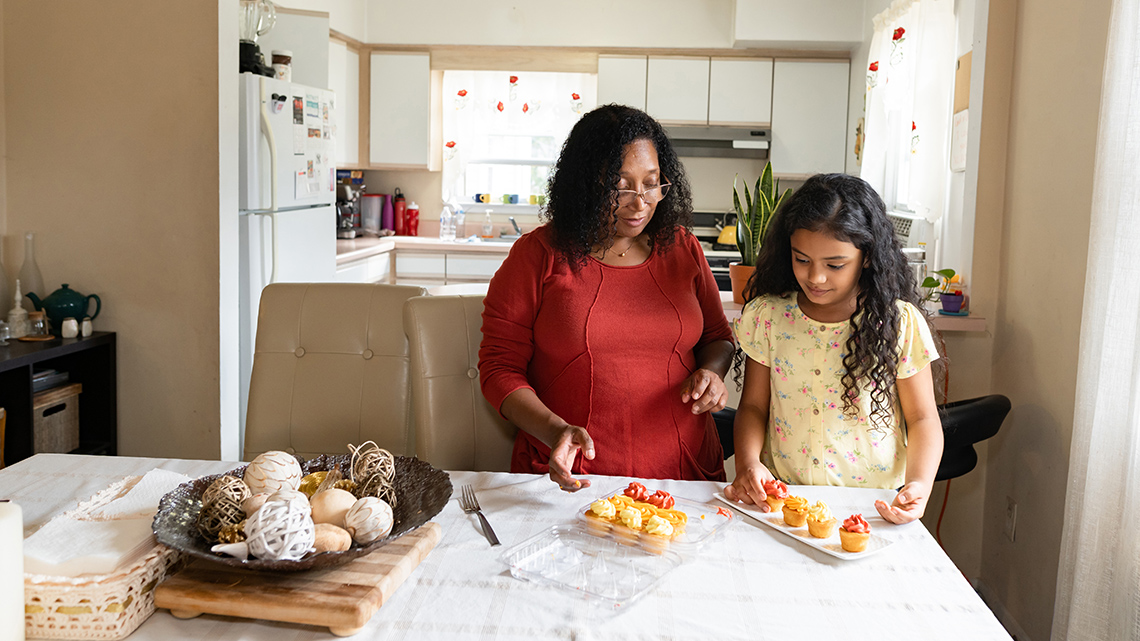Minds On
Multiplication using mental math

Have you ever tried to fit pieces of furniture into a space, tried to separate items into equal groups, calculate the area of a rectangular room, or set up a tray of muffins on a platter? You may not have realized that you were actually doing multiplication. Multiplication is when we use repeated addition, arrays, or multiple equal groups to calculate the total. Multiplication comes in many shapes and forms and we use it on a regular basis with our day-to-day activities. If a baker was to make 4 trays of 12 cookies, how many cookies would they have in total? To answer this question, you would need to figure out 12 × 4. What strategies or steps would you take to complete this? What tips about multiplication could help you figure it out?
Action
Multiplication strategies
Let’s review some strategies that we can use to help us multiply large numbers.
Matrix method
Let’s explore the following video entitled “Matrix Multiplication” to learn how to use a matrix to multiply 2-digit by 1-digit numbers using mental math.
Expanded form
Start by expressing your multiplication sentence. Then, divide each number into its tens and ones. Multiply each tens and ones by the tens and ones in your second number. You should end up with four multiplication sentences. Once you have answered all of those multiplication sentences, add them up to get your final answer.
The following image shows an example of a diagram of the “breaking apart” method for the multiplication question 42 × 35. Explore and discuss this method with a partner, if possible.
Factor trees
Factor trees are also helpful when you are separating numbers into their place value because even though it could be easy to multiply 40 and 2 with 30 and 5 as demonstrated in this example, sometimes other numbers need to be divided up further to multiply quicker. For example, 94 might be okay to represent as 90 and 4 but it can also be expanded into 3 × 30 and 4.
Let’s examine the following image with a diagram of a factor tree for the number 60:
Algorithm
Record your multiplication sentence vertically, as you would normally record your addition or subtraction problem. We will multiply using our bottom number as a guide. Multiply the ones in your bottom number with the ones on top, and then the tens on top. Next, place a zero as a place holder in the ones column. Then, use the tens digit of the bottom number to multiply with the ones, followed by the tens of the top number. Once you have finished that, add the numbers together to get your final answer.
Multiplying decimals
Don’t forget that when you multiply using decimals, you can first ignore the decimals and multiply. Then, count how many decimal places are being used in the two numbers. In the following example, there are three decimal places in total. You would then add the decimal to your number, starting at the right of your number and counting three decimal places over.
Task: Maximizing area

The city has decided that they will be building a new rectangular-shaped community centre. It has found a vacant piece of land that is 45.3 m wide maximum. They could purchase less if they prefer. They haven’t decided on the depth of the building yet. However, they know that the total area cannot exceed 2,000 square meters. Area is the length × width. For example, we could suggest that the dimensions are 5 m × 10 m but that wouldn’t be large enough or really take up the allotted space. What are some possible dimensions of this new community centre? What would be the best use of space and create the maximum area?
If you would like, you can complete this activity using TVO Mathify. You can also use your notebook or the fillable worksheet.
Press the ‘TVO Mathify' button to access this interactive whiteboard and the ‘Activity’ button for your note-taking document. You will need a TVO Mathify login to access this resource.
TVO Mathify (Opens in new window) Activity (Open PDF in a new window)Consolidation
Everyday expenses

Imagine that the bus in a city or town costs $2.25 for a one ride fare, $10.75 for a weekly pass, and $45 for a monthly pass. How many days would a rider need to ride the bus before it becomes a better deal to purchase the monthly pass? Use two different multiplication strategies to find your answer. If possible, compare your answers with a partner. Which strategy did you find easiest to use?
If you would like, you can complete this activity using TVO Mathify.
Reflection
As you read through these descriptions, which sentence best describes how you are feeling about your understanding of this learning activity? Press the button that is beside this sentence.
I feel...
Now, record your ideas using a voice recorder, speech-to-text, or writing tool.
Connect with a TVO Mathify tutor
Think of TVO Mathify as your own personalized math coach, here to support your learning at home. Press ‘TVO Mathify’ to connect with an Ontario Certified Teacher math tutor of your choice. You will need a TVO Mathify login to access this resource.
TVO Mathify (Opens in new window)